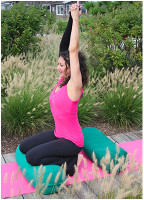 |
Three Keys to Manage Breast Cancer-Related Lymphedema
|
 Breast Cancer-Related Lymphedema (BCRL) is more common then you would think after surgery or treatment. BCTL can be quite devastating to patients, as its far reaching consequences are a constant reminder of their cancer. It is also one of those things that is not given enough attention to and happens without any fanfare from the doctors so you are left most often wondering What is this?, How can I stop the pain and swelling? Will it go away? Unfortunately once you have lymphedema - you have it. You will need to learn to manage it.
Breast Cancer-Related Lymphedema (BCRL) is more common then you would think after surgery or treatment. BCTL can be quite devastating to patients, as its far reaching consequences are a constant reminder of their cancer. It is also one of those things that is not given enough attention to and happens without any fanfare from the doctors so you are left most often wondering What is this?, How can I stop the pain and swelling? Will it go away? Unfortunately once you have lymphedema - you have it. You will need to learn to manage it.
StepUp-SpeakOut.Org posted these two articles that were immensely informative on BCRL http://www.lymphormation.org/journal/content/0701_yoga.pdf, http://www.lymphormation.org/journal/content/0701_yoga.pdf that put such a smile on my face. More often than not findings of research and study on yoga and lymphedema are limited in scope, so when I came across trials that support and promote yoga, breathing and relaxation I become quite excited about sharing this positive information.
-
The three keys of an integrated yoga program that may be well suited in a holistic self management for BCRL lymphedema are:
-
Yoga - Use arm movements that are gentle and flowing. Combined these movements with a synchronized deep breath. For example, inhale arms up, exhale and lower arms. This will help create a relaxed state of mind, and release muscle tension. It was stated in studies that significant improvement to arm sensations of heaviness and limb size was supported in the reduction of chest density and the noticeable softening of adhesions and fibrous of the soft tissue. The authors (McClure etal 2010) stated "that the sequencing of movement with breathing would promote lymph flow and thoracic emptying while at the same time reducing stress and negative mood, leading to improved immune function in what they described as a circle of healing."
Breathing - Breathing is one of the most important tools in yoga to help manage breast cancer-related lymphedema. Too many times I have read or heard from other instructors that holding the breath in (breath retention) was not good for lymphedema. I now read it is better than good. It helps to create pressure changes that empty the lymphatic system into the Venus system at the thoracic ducts and clear the lymphatic pathways. This happens both before the pose begins and again when the pose is finished. (Vaqas etal, 2003). It is also mentioned a long, slow breath may improve the elasticity of the secondary inhalation muscles, the pectoral minor, major and serratus anterior. These muscles can become impaired from surgery and radiation. Breathing correctly and consciously is one of the best things we can do for ourselves.
Relaxation, Meditation or Mindfulness - These practices that are introduced to breast cancer patients have shown to reduce stress and improve mood, boost immune function and increase one's quality of life. Relaxation and/or meditation bring changes to the nervous system that create calm and initiate lymphatic drainage. When the affected arm is elevated during the relaxation portion of the class, both the body cools down, thus increasing the parasympathetic nervous system response and the initiation of lymphatic drainage.
These overall findings support the opinion that exercise, breathing and relaxation may offer another self-management tool for patients with breast cancer-related lymphedema. Self management may also include attention to skin care and self massage, wearing a compression sleeve, elevating the affected arm and knowledge of any other risk reduction.
Use non-straining poses that focus on the breath and on relaxing the mind. Choose yoga poses that work on clearing the lymph nodes in the arm from proximal to distal, and then from the shoulder out and down to the hand. Tensing muscles at the top of the inhale will help facilitate pressure changes for the flow of lymph. Lymph flow is slow moving and so should the flow of the pose. This will allow the lymph collectors to fill and empty. After a sequences of poses, it is recommended that rest follows. This will promote relaxation.
It is important to note, Use moderation when starting something new or when returning. I also want to mention that it is important to do your yoga in a room where the temperature is comfortable, not hot. Hot yoga is not recommended; it is contraindicated as heat will add to the lymphatic load. Some may want to wear a compression sleeve and gauntlet if swollen, if not swollen do not restrict the arm.
Even with my excitement I must say that when working with lymphedema the teacher and students must be vigilant about limits, appropriate warms ups and cool downs, use of bandages or not, and over exertion. You can go to the Breast Cancer Yoga Authority blog www.breastcanceryogablog.com and read up on all special articles from very special contributors. They are there to serve - so please ask questions.
|
|
You are welcome to share this © article with friends, but do not forget to include the author name and web address. Permission needed to use articles on commercial and non commercial websites. Thank you. Search CancerLynx |